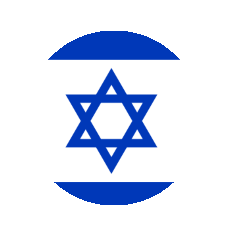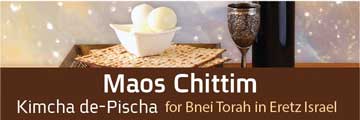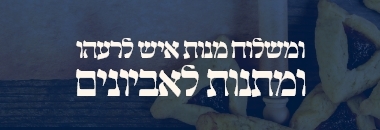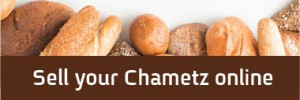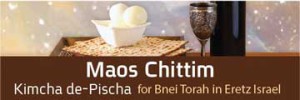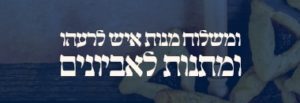Part II
This week we will focus on different interactions with muktza. Which are permitted and which – prohibited? This week’s article will also touch upon expensive or precious muktza – how can it be preserved or protected on Shabbos? Animal care is also on the menu this week – how to care for pets or livestock on Shabbos which are, as stated last week, muktza. How is New York City different from Small Town America? Who can move a Slicer® and who cannot? How come a pot is muktza in one family but not in another? What about a food processor? Of this and more in the coming article.
Sources
In this week’s parasha we learn how the Mishkan was built. The Gemoro teaches us that the actions prohibited on Shabbos are those that were done for constructing the Mishkan. Rav S. R. Hirsch explains that Shabbos prohibitions are not necessarily strenuous work but rather creative actions. In building the Mishkan, as a symbol of the entire creation, its builders represented the creation of the world. To learn the laws of Shabbos, which commemorates G-d’s resting from the Six Days of Creation, we refer to the actions done for constructing the Mishkan.
The 39 work categories make up the Torah-mandated laws of Shabbos. The prophets added additional obligations in order to help us to feel that all our work is done. To that end, Chazal instituted the prohibition of muktza, enabling people to thoroughly detach both in mind and body from all mundane activities.
In last week’s article we defined the two categories of muktza. The first is raw material, undesignated for any use. The other is a tool designed for use, whether prohibited or permitted on Shabbos.
This week’s article will provide further details on the prohibition of muktza: which interactions are permitted, and which are prohibited.
Moving Muktza
Since the purpose of muktza is to detach, both physically and mentally, from anything non-Shabbos related, the main prohibition involves moving muktza with our hands. Transporting it indirectly may be permitted under certain circumstances which will be detailed further on.
Chazal list several ways of interacting with muktza:
- Moving it with the hands.
- Moving it with the hands when there is a permitted object on top of it, and both are transported together at once.
- Purposely moving muktza via another object — stick, knife, pulling something else out from under it, etc.
- Moving muktza indirectly via a body limb other than the hand – an elbow, knee, foot or back.
- Touching muktza without moving it.
Rules of Muktza
Moving muktza directly with one’s hands (1) is prohibited.
Moving muktza directly along with a permitted object on top of it (2) is also usually prohibited, with the exception made for specific circumstances.
Moving muktza via another object (3) is permitted only when the reason is permitted – the place the muktza is taking up is necessary for something else, for example. Therefore, if there is a bag of uncooked rice standing in front of a challah, the bag of rice can be pushed aside via pulling out the challah, or with a knife or stick.
Physically moving muktza (4) in an abnormal way is permitted, even when the purpose of moving it is for the muktza — to preserve it so it won’t be damaged or stolen.
Touching muktza without moving it (5) is also permitted.
Moving Muktza Abnormally vs. Via Another Object
When the normal manner of transporting a muktza is via another body part besides the hands, it is categorized as muktza which can be moved only for permitted reasons (3). However, when moving it to prevent a loss or for a necessity the Mishna Brura (308:13) seems to permit it, as does Rabbi Moshe Feinstein (Igros Moshe OC volume V, responsum 22:6).
No Hands
According to the Shulchan Aruch (OC 308:43), blowing on muktza to make it move is permitted, since blowing is not the regular manner of moving something. The Rama (ibid:3) explains that this follows the rule permitting moving muktza in an abnormal manner. Rabbi Moshe Feinstein (Igros Moshe OV volume V 22:8) clarifies that the abnormal manner of transporting must be a noticeable difference, not merely a slight change in manner. While muktza can be pushed with an elbow or foot, Rav Moshe remains with a doubt whether one may move it with the back of the hand.
Touching
Touching muktza without moving it is permitted (Shulchan Aruch OC 308:42).
Shulchan Atzei Shittim (chapter 2:1) adds that if touching will cause the muktza to move or swing, touching it for the muktza’s sake is forbidden. But if touching will not cause it to move, it is always permitted. Therefore, one can stretch a cover over his car to protect the paint from fading because when doing so the car won’t move.
If one does not intend to move muktza he may do an action that may possibly cause the muktza to move . Therefore, one is permitted to lean on a table on which there is money even though the money may move. Since it is an uncertain result and not intended for preserving the money, leaning on it is permitted (Mishna Brura 309:15).
The Mishna Brura adds (308:19) that one is permitted to take something that is situated on top of a muktza object even though the muktza may move slightly. Only if done for the muktza is that slight touch prohibited.
Since touching muktza without moving it is permitted, one can sit on a rock or car hood on Shabbos. Actually, sitting is permitted even if it may move since it is done with another body part besides the hands.
Muktza Along With Non-Muktza
A raw-material muktza cannot be moved at all even if not done for the muktza object. Therefore, a rock cannot be moved out of a yard even if its spot is needed to set up a table for a Shabbos kiddush or it is needed to hold down a pile of paper plates in the wind. Even if something permitted (like paper plates) are placed atop of it, moving it remains forbidden (Shulchan Aruch OC 311:5).
This rule has one exception: death. When a person passed away where his body can be disfigured and disgraced (under the beating sun, or where wild animals roam) until Shabbos is over, where there is no other option Chazal permit placing a non-muktza object such as a food item or baby on top of the body and transporting it together with the object on top. This manner of transporting is considered interacting with the permitted object, not with the corpse (Shulchan Aruch OC 311:1).
Tools intended for forbidden actions are subject to debate. The Shulchan Aruch (308:5) cites an opinion that permits transporting a muktza tool if there if a permitted object is placed on top of it, even if moving it is for the forbidden object. Therefore, according to the Shulchan Aruch one can place an apple on top of a cell phone and move it away out of children’s reach. However, the Misha Brura (308:26) notes that the Achronim forbid doing so. He adds, however, that the Shulchan Aruch HaRav (quoted in Sha’ar Hatziun 308:24) rules that where a great loss involved one can be lenient.
Moving a Tool with its Content
A pot since it is also used to store food is considered a tool for forbidden and permitted uses which may be transported even for protecting the tool (Shmiras Shabbos Kehilchaso 20:15). Rav Nissim Karelitz maintains, though, that if the utensil’s main use is for cooking it is considered a tool for forbidden actions even if it is also used for storing food. As such, it can only be transported for a permitted use or when the space it takes up is necessary, not for preserving or protecting it.
Pans or food processor pieces that don’t usually serve for food storage are certainly considered tools for forbidden uses. However, as long as there is food inside, they remain tools for permitted uses (Mishna Brura 308:26). Rav Nissim Karelitz adds here a caveat: only if the food remained from the original use or was purposely placed there for storage can it be considered as such, not if the food was placed there only in order to change its status.
A pot or any receptacle containing rotten or otherwise unwanted food remains can be removed as per the halacha of removing trash (Biur Halacha 308:5).
Muktza status can depend on who is the owner of a utensil. For people who never store their food in pots and use them only for cooking pots are muktza whereas for people who always store their food in the pots it was cooked in pots are not muktza.
The Slicerâ is another example. While many store the chopped vegetables in the receptacle under the chopper, some do not. For those who always store their salad in the container, the Slicer is a tool for permitted use which can be transported on Shabbos, but people who never store their vegetable inside can only transport it while there are vegetables inside.
Pets and Livestock
Animals are raw material, and therefore muktza on Shabbos (Shulchan Aruch OC 308:39). If the animal will suffer, moving it is possible according to the rules detailed below.
Where possible, an animal can be moved by lifting one part – its front or hind legs, for example, or directing it by turning its head. This is not an option with birds because they lift themselves (Shulchan Aruch IC 308:40).
Therefore, if a dog will suffer discomfort, it can be walked or directed to a safe spot. However, lifting it up for play is forbidden.
Moving a fish tank along with the fish inside is forbidden (Rav Moshe Feinstein, Igros Moshe OC volume IV 16). While Shmiras Shabbos Kehilchaso sees a fish tank as a home decoration, he, too, requires an extra scrupulousness with it. (Where the fish tank has electronic elements there may be other issues involved as well.)
Where the public domain is Torah-mandated (such as the streets of Manhattan) walking a dog is prohibited out of concern the walker may accidently lift it up. But in side streets or unfenced private yards, which are rabbinic public domains, walking a dog is permitted (as well as in any neighborhood where the rabbonim ruled the streets are not a Torah-mandated public domain.) However, some prohibit walking dogs wherever there is no eiruv.

